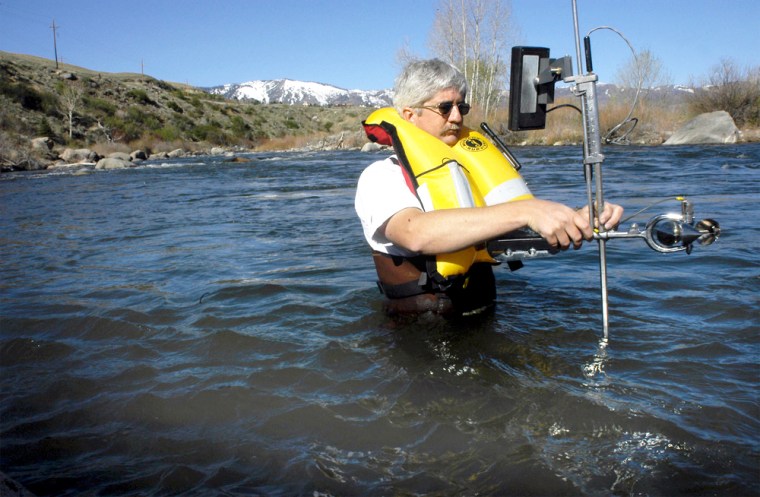From the brittle hillsides of Southern California to the drying fields of Idaho, from Montana to New Mexico, a relentless drought is worsening across most of the West, water supplies are dwindling and the threat of wildfires is rising.
“Most of the West is headed into six years of drought and some areas are looking at seven years of drought,” said Rick Ochoa, weather program manager at the National Interagency Fire Center in Boise, Idaho.
Arizona is facing its worst drought on record. Two enormous reservoirs on the Colorado River are only half full. Some farmers in southern Idaho might not get any irrigation water this summer, and irrigators in western Nevada are threatening war with a country club that wants green grass for a national golf tournament.
The mountain snowpack, a crucial reservoir that in a good year holds water until it’s needed, was half of the normal March level or less in many areas.
“We had one of the warmest Marches on record ... and we didn’t get any precipitation almost anywhere in the West,” said Kelly Redmond, regional climatologist for the Desert Research Institute’s Western Regional Climate Center in Reno. “So not only did we not add to our supply in March, which is usually a very healthy month, but the temperature was so warm that the melting started early.”
Other states
The mountains of Colorado and northern New Mexico got more than a foot of snow this weekend, and meteorologists said the Albuquerque area could be looking at record rainfall this month, but it’s only a start toward recovery.
“It’ll help. It just depends on how soon the next one comes,” farmer Larry Palser said in Colorado’s Washington County. “It’ll buy us some time.”
The U.S. Natural Resources Conservation Service says there’s a potential for water restrictions and widespread crop and pasture losses in central Nevada, southern Idaho, most of south-central Montana and eastern and southwestern Utah.
Most of southern Idaho and parts of southwest Montana are in “exceptional drought,” the U.S. Department of Agriculture says. That’s a step worse than “extreme drought,” which the USDA says best describes other parts of Montana, Utah, Wyoming, Arizona, New Mexico, Nevada, Oregon and Colorado.
'Real nervous' about fires
With dry trees raising the risk of wildfires, it’s not just farmers who will be hurting. Already this year, 10,000 acres have burned in Arizona, along with 8,500 acres in Colorado.
“In terms of fire, I think everybody is real nervous,” said Chris West, vice president of the American Forest Resource Council in Portland, Ore.
The National Interagency Fire Center identified three areas with the greatest fire risks — Southern California; the Four Corners region of Arizona, New Mexico, Colorado and southern Utah; and the Intermountain region east of the Cascade Mountains through Idaho into western Montana.
One of the hardest hit areas in Idaho is in the state’s southeast corner at Bear Lake, which provides water to parts of Idaho, Wyoming and Utah.
“It’s entirely possible there will be no irrigation water available for farmers down there,” said Dick Larsen, spokesman for the Idaho Department of Water Resources.
Cattle vs. golf
In Reno, which recorded its warmest March since 1934, residents have asked the state to re-evaluate the Montreux Golf & Country Club’s use of water from Galena Creek. They’re worried about pastures for their livestock, not greens for the PGA Tour and the Reno-Tahoe Open.
“You are going to have a new range war, the farmers and ranchers against the golf courses,” Rick Taras, president of the Big Ditch Co., told the Reno-Gazette Journal last week.
In contrast, some parts of the West — western Oregon, Washington and Northern California west of the Cascades and Sierra Nevada — have near normal snowpack.
Statewide, California’s overall water supply situation is “not great, but it’s OK,” said Frank Gehrke, chief of snow surveys for the California Department of Water Resources. Southern California, however, “is not doing particularly well.”
Parts of Nevada, Southern California and Arizona are dependent on the Colorado River and its two largest reservoirs, Lake Mead and Lake Powell, which together can hold about 50 million acre feet.
This year, however, Mead and Powell are only about half full.
“We thought this was going to be a decent year, but now it’s starting to look like that is not going to be the case,” Redmond said.
“Pray for rain,” Larsen said in Idaho. “That’s about all we can do.”
